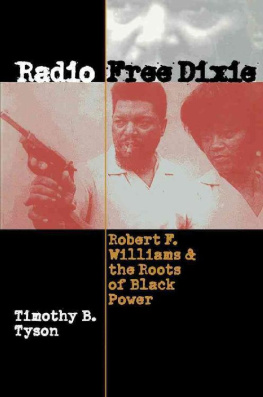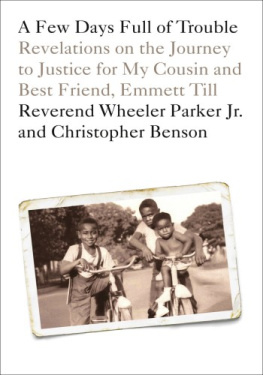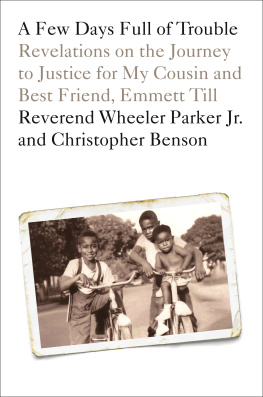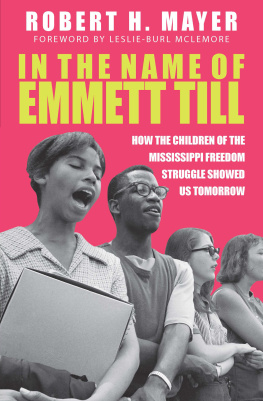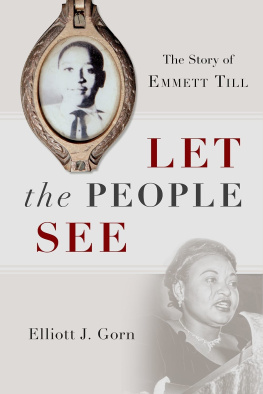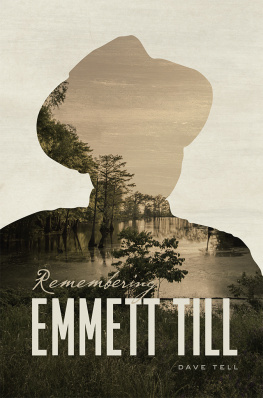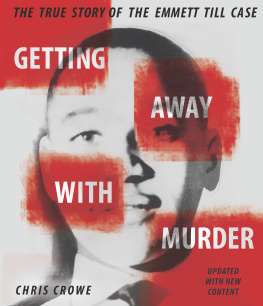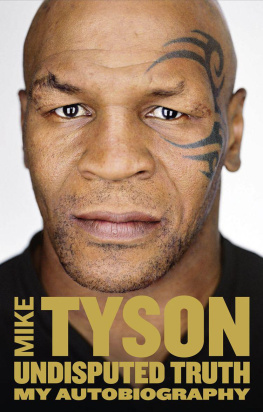Timothy B. Tyson - The Blood of Emmett Till
Here you can read online Timothy B. Tyson - The Blood of Emmett Till full text of the book (entire story) in english for free. Download pdf and epub, get meaning, cover and reviews about this ebook. year: 2017, publisher: Simon & Schuster, genre: Non-fiction / History. Description of the work, (preface) as well as reviews are available. Best literature library LitArk.com created for fans of good reading and offers a wide selection of genres:
Romance novel
Science fiction
Adventure
Detective
Science
History
Home and family
Prose
Art
Politics
Computer
Non-fiction
Religion
Business
Children
Humor
Choose a favorite category and find really read worthwhile books. Enjoy immersion in the world of imagination, feel the emotions of the characters or learn something new for yourself, make an fascinating discovery.

- Book:The Blood of Emmett Till
- Author:
- Publisher:Simon & Schuster
- Genre:
- Year:2017
- Rating:3 / 5
- Favourites:Add to favourites
- Your mark:
- 60
- 1
- 2
- 3
- 4
- 5
The Blood of Emmett Till: summary, description and annotation
We offer to read an annotation, description, summary or preface (depends on what the author of the book "The Blood of Emmett Till" wrote himself). If you haven't found the necessary information about the book — write in the comments, we will try to find it.
The Blood of Emmett Till — read online for free the complete book (whole text) full work
Below is the text of the book, divided by pages. System saving the place of the last page read, allows you to conveniently read the book "The Blood of Emmett Till" online for free, without having to search again every time where you left off. Put a bookmark, and you can go to the page where you finished reading at any time.
Font size:
Interval:
Bookmark:
Thank you for downloading this Simon & Schuster eBook.
Join our mailing list and get updates on new releases, deals, bonus content and other great books from Simon & Schuster.
C LICK H ERE T O S IGN U P
or visit us online to sign up at
eBookNews.SimonandSchuster.com
We hope you enjoyed reading this Simon & Schuster eBook.
Join our mailing list and get updates on new releases, deals, bonus content and other great books from Simon & Schuster.
C LICK H ERE T O S IGN U P
or visit us online to sign up at
eBookNews.SimonandSchuster.com
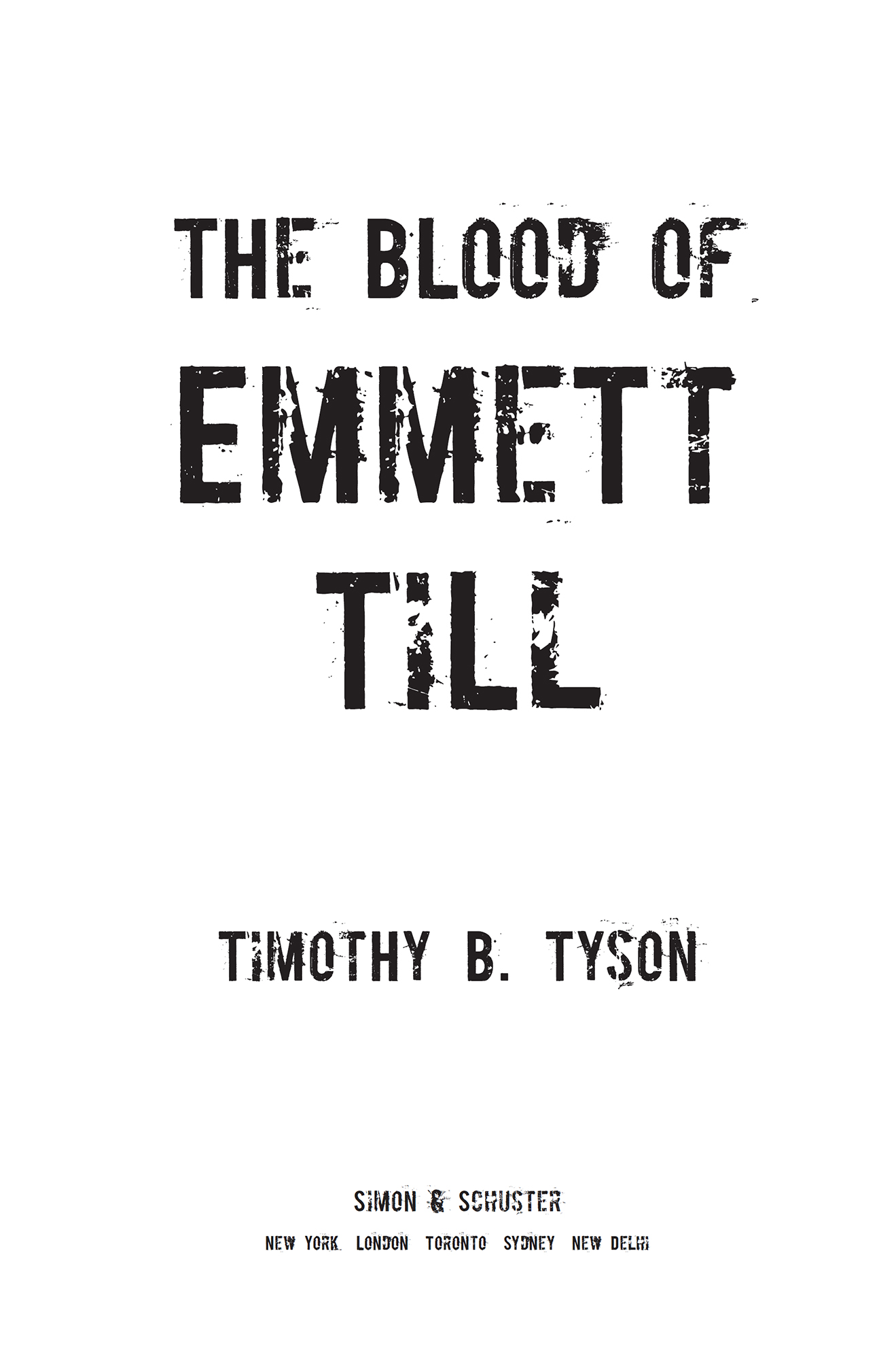
ALSO BY TIMOTHY B. TYSON
BLOOD DONE SIGN MY NAME: A TRUE STORY
RADIO FREE DIXIE: ROBERT F. WILLIAMS AND THE ROOTS OF BLACK POWER

Simon & Schuster
1230 Avenue of the Americas
New York, NY 10020
www.SimonandSchuster.com
Copyright 2017 by Timothy Tyson
All rights reserved, including the right to reproduce this book or portions thereof in any form whatsoever. For information address Simon & Schuster Subsidiary Rights Department, 1230 Avenue of the Americas, New York, NY 10020.
First Simon & Schuster hardcover edition February 2017
SIMON & SCHUSTER and colophon are registered trademarks of Simon & Schuster, Inc.
For information about special discounts for bulk purchases, please contact Simon & Schuster Special Sales at 1-866-506-1949 or .
The Simon & Schuster Speakers Bureau can bring authors to your live event. For more information or to book an event contact the Simon & Schuster Speakers Bureau at 1-866-248-3049 or visit our website at www.simonspeakers.com.
Interior design by Ruth Lee-Mui
Jacket Design by Archie Ferguson
Library of Congress Cataloging-in-Publication Data
Names: Tyson, Timothy B., author.
Title: The blood of Emmett Till / Timothy B. Tyson.
Description: New York : Simon & Schuster, [2017] | Includes bibliographical references and index.
Identifiers: LCCN 2016021595 (print) | LCCN 2016023098 (ebook) | ISBN 9781476714844 (hardcover) | ISBN 9781476714851 (pbk.) | ISBN 9781476714868 (ebook) | ISBN 9781476714868 (E-Book)
Subjects: LCSH: Till, Emmett, 1941-1955. | LynchingMississippiHistory20th century. | African AmericansCrimes againstMississippi. | RacismMississippiHistory20th century. | Trials (Murder)MississippiSumner. | Hate crimesMississippi. | United StatesRace relationsHistory20th century. | MississippiRace relations.
Classification: LCC HV6465.M7 T97 2017 (print) | LCC HV6465.M7 (ebook) | DDC 364.1/34dc23
LC record available at https://lccn.loc.gov/2016021595
ISBN 978-1-4767-1484-4
ISBN 978-1-4767-1486-8 (ebook)
for my brother Vern
My name is being called on the road to freedom. I can hear the blood of Emmett Till as it calls from the ground....When shall we go? Not tomorrow! Not at high noon! Now!
REVEREND SAMUEL WELLS , Albany, Georgia, 1962
T he older woman sipped her coffee. I have thought and thought about everything about Emmett Till, the killing and the trial, telling who did what to who, she said. Almost eighty and still handsome, her hair now silver, the former Mrs. Roy Bryant served me a slice of pound cake, hesitated a little, and then murmured, seeming to speak to herself more than to me, Theyre all dead now anyway. She placed her cup on the low glass table between us, and I waited.
For one epic moment half a century earlier, Carolyn Bryants face had been familiar across the globe, forever attached to a crime of historic notoriety and symbolic power. The murder of Emmett Till was reported in one of the very first banner headlines of the civil rights era and launched the national coalition that fueled the modern civil rights movement. But she had never opened her door to a journalist or historian, let alone invited one for cake and coffee. Now she looked me in the eyes, trying hard to distinguish between fact and remembrance, and told me a story that I did not know.
The story I thought I knew began in 1955, fifty years earlier, when Carolyn Bryant was twenty-one and a fourteen-year-old black boy from Chicago walked into the Bryants Grocery and Meat Market in a rural Mississippi Delta hamlet and offended her. Perhaps on a dare, the boy touched or even squeezed her hand when he exchanged money for candy, asked her for a date, and said goodbye when he left the store, tugged along by an older cousin. Few news writers who told the story of the black boy and the backwoods beauty failed to mention the wolf whistle that came next: when an angry Carolyn walked out to a car to retrieve the pistol under the seat, Till supposedly whistled at her.
The world knew this story only because of what happened a few days later: Carolyns kinsmen, allegedly just her husband and brother-in-law, kidnapped and killed the boy and threw his body in the Tallahatchie River. That was supposed to be the end of it. Lesson taught. But a young fisherman found Tills corpse in the water, and a month later the world watched Roy Bryant and J. W. Big Milam stand trial for his murder.
I knew the painful territory well because when I was eleven years old in the small tobacco market town of Oxford, North Carolina, a friends father and brothers beat and shot a young black man to death. His name was Henry Marrow, and the events leading up to his death had something in common with Tills. My father, a white Methodist minister, got mixed up in efforts to bring peace and justice to the community. We moved away that summer. But Oxford burned on in my memory, and I later went back and interviewed the man most responsible for Marrows death. He told Carolyn Bryant Donham had read the book, which was why she decided to contact me and talk with me about the lynching of Emmett Till.
The killing of Henry Marrow occurred in 1970, fifteen years after the Till lynching, but unlike the Till case it never entered national or international awareness, even though many of the same themes were present. Like Till, Marrow had allegedly made a flirtatious remark to a young white woman at her familys small rural store. In Oxford, though, the town erupted into arson and violence, the fires visible for miles. An all-white jury, acting on what they doubtless perceived to be the values of the white community, acquitted both of the men charged in the case, even though the murder had occurred in public. What happened in Oxford in 1970 was a late-model lynching, in which white men killed a black man in the service of white supremacy. The all-white jury ratified the murder as a gesture of protest against public school integration, which had finally begun in Oxford, and underlying much of the white protest was fear and rage at the prospect of white and black children going to school together, which whites feared would lead to other forms of race-mixing, even miscegenation.
As in the Marrow case, many white people believed Till had violated this race-and-sex taboo and therefore had it coming. Many news reports asserted that Till had erredin judgment, in behavior, in deed, and perhaps in thought. Without justifying the murder, a number of Southern newspapers argued that the boy was at least partially at fault. The most influential account of the lynching, Huies 1956 presumptive tell-all, The story was told and retold in many ways, but a great many of them, from the virulently defensive accounts of Mississippi and its customs to the self-righteous screeds of Northern critics, noted that Till had been at the wrong place at the wrong time and made the wrong choices.
Next pageFont size:
Interval:
Bookmark:
Similar books «The Blood of Emmett Till»
Look at similar books to The Blood of Emmett Till. We have selected literature similar in name and meaning in the hope of providing readers with more options to find new, interesting, not yet read works.
Discussion, reviews of the book The Blood of Emmett Till and just readers' own opinions. Leave your comments, write what you think about the work, its meaning or the main characters. Specify what exactly you liked and what you didn't like, and why you think so.

